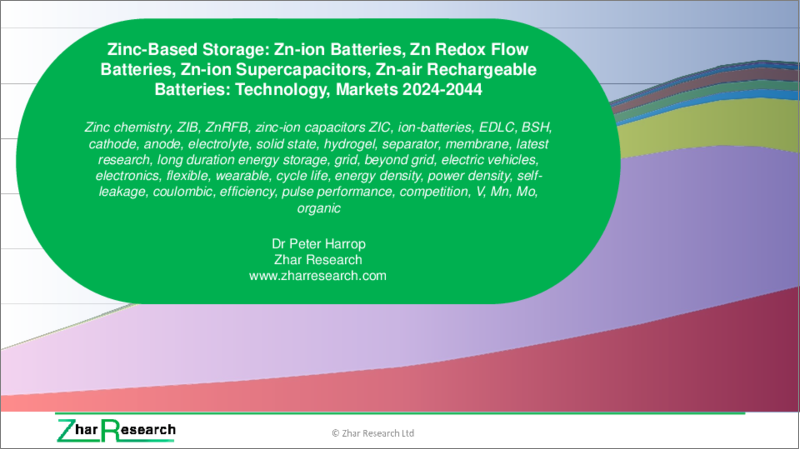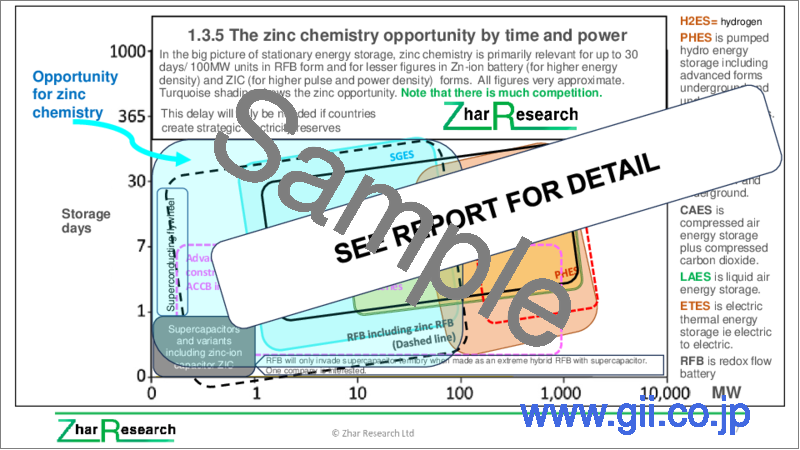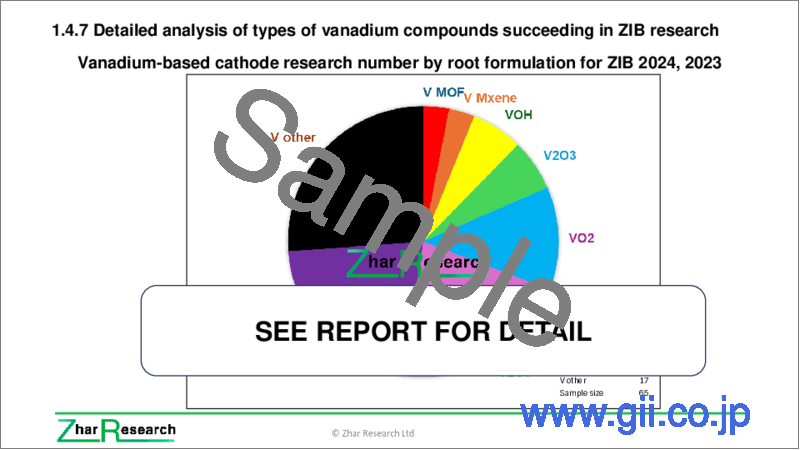|
|
市場調査レポート
商品コード
1478183
亜鉛ベースストレージ:亜鉛イオン電池・亜鉛レドックスフロー電池・亜鉛イオンスーパーキャパシタ・亜鉛空気二次電池:各種技術および市場 (2024-2044年)Zinc-based storage: Zn-ion batteries, Zn redox flow batteries, Zn-ion supercapacitors, Zn-air rechargeable batteries: technologies, markets 2024-2044 |
||||||
|
|||||||
| 亜鉛ベースストレージ:亜鉛イオン電池・亜鉛レドックスフロー電池・亜鉛イオンスーパーキャパシタ・亜鉛空気二次電池:各種技術および市場 (2024-2044年) |
|
出版日: 2024年05月13日
発行: Zhar Research
ページ情報: 英文 397 Pages
納期: 即日から翌営業日
|
全表示
- 概要
- 目次
エネルギー貯蔵の市場は今後20年間で6倍に成長しますが、ニーズと技術も大きく変化します。
当レポートでは、亜鉛ベースのストレージの技術および市場を調査し、亜鉛イオン電池、亜鉛レドックスフロー電池、亜鉛イオンスーパーキャパシタ、亜鉛空気二次電池の技術概要、R&Dの動向、主な研究の詳細な評価、亜鉛ベースの電池およびその他のストレージ技術の市場規模の推移・予測などをまとめています。
亜鉛イオン電池の研究レポートの焦点に関する分析 (2024年・2023年):サンプル数:263件

BSH (バッテリースーパーキャパシタハイブリッド) 市場:タイプ別 (2024-2044年):

目次
第1章 エグゼクティブサマリー・総論
- このレポートの目的
- 調査手法
- 主な結論
- 亜鉛イオン電池:分析と主な結論
- 亜鉛イオン電池とスーパーキャパシタのハイブリッド:亜鉛イオンキャパシタZIC:分析、主な結論
- 亜鉛レドックスフロー電池:分析、主な結論
- 空気亜鉛電池
- 技術と市場のロードマップ
- 市場予測
第2章 エネルギー貯蔵と亜鉛の役割
- エネルギー貯蔵の概要
- LDES (Long Duration Energy Storage)
- 充電式亜鉛イオン電池の競合に関する誤解
- エネルギー貯蔵の世界におけるイオン電池
- 亜鉛電池:小型使い捨て電池の成功から将来の大型充電式電池への転換
- さまざまな形態の亜鉛充電式エネルギー貯蔵に関する現実的な研究目標
- エネルギー密度スペクトルによるリチウムイオンコンデンサLIC市場:亜鉛の機会に
第3章 電池などに亜鉛が使用される理由
- 概要
- エネルギー貯蔵の重要要件と2044年の技術リーダー候補
- 充電式亜鉛イオン電池の夢
- グリッド要件の誤解
- 亜鉛イオンの現実と魅力的な理論上の性能
- バッテリー内のロケーションによるZnイオンの問題と対策
- スマートZIBのその後の開発
- 亜鉛イオン電池の改良にレドックス機構が活用される
- 水性亜鉛イオン電池の全体的な進歩
- 研究中の亜鉛系二次電池のパラメータ
- フレキシブルおよび固体亜鉛イオン電池とマイクロ電池
- Zhar Researchによる2024年、2023年の充電式亜鉛イオン電池に関する調査の統計分析
- 亜鉛イオン電池メーカーおよび製造元候補の例
- Eos Energy Enterprises USA
- Enzinc USA
- Gelion Australia
- Urban Electric Power USA
第4章 亜鉛イオンアノード研究の進歩:2024年・2023年
- アノードの問題とアプローチ
- 2019年から2024年までの進捗状況の概要
- 2024年・2023年のZIBアノード研究論文の統計分析:有望材料が明らかに
- 2024年・2023年のZnイオンアノード研究の詳細な評価
- 亜鉛充電式マイクロ電池用アノード
第5章 亜鉛イオンカソード研究の進歩:2024年・2023年
- 概要
- 2024年・2023年のZIBカソード研究論文の統計分析:有望材料が明らかに
- 2024年・2023年のZnイオンカソード研究の詳細な評価
- バナジウム化合物
- マンガン化合物
- モリブデン化合物
- その他の材料
第6章 亜鉛イオン電解質研究の進歩:2024年・2023年
- 概要
- 2024年・2023年のZIB電解質研究論文の統計分析:有望材料が明らかに
- 2024年・2023年のZnイオン電解質研究の詳細な評価
第7章 亜鉛イオン分離膜研究の進歩:2024年・2023年
- 概要
- 膜の難易度と使用および提案された材料:例
- 2024年・2023年の亜鉛イオン分離器研究の詳細な評価
第8章 亜鉛イオン電池とスーパーキャパシタのハイブリッド:ZIC (亜鉛イオンキャパシタ)
- スーパーキャパシタとそのハイブリッドのイントロダクション
- スーパーキャパシタとその変種のSWOT評価
- ナトリウムイオンコンデンサSICの2024年のブレークスルー:ZICの競合
- 2024年・2023年の亜鉛ベースハイブリッドスーパーキャパシタに関する研究の評価
第9章 亜鉛レドックスフロー電池
- 従来型およびハイブリッド型レドックスフロー電池の概要とSWOT評価
- 電池、ハイブリッドRFB、従来のRFBのパラメータスペクトル
- RFB:覆される業界
- 販売量におけるRFBの7つのパラメータ:バナジウム vs その他 (2024~2044年)
- 亜鉛RFB技術がRFBビジネスに進出:市場予測・企業・研究の分析
- 難易度と使用材料によるRFB膜の重要性と化学
- 亜鉛RFBメーカープロファイル:2024年
- 研究パイプラインの分析:2024年・2023年
- 概要
- 亜鉛臭素
- 亜鉛ヨウ素
- 亜鉛鉄
- 亜鉛マンガン
- 亜鉛バナジウム
The energy storage market will grow sixfold over the coming 20 years but change radically in both needs and technologies. What place will zinc technology have in all this? What are the opportunities for those making appropriate added value materials and making and using the devices themselves? Rechargeable versions will be paramount and the winning materials and applications have been established from a deep study of the research pipeline, expert opinions and fundamentals. Uniquely, the answers are in the new report, "Zinc-based storage: Zn-ion batteries, Zn redox flow batteries, Zn-ion supercapacitors, Zn-air rechargeable batteries: technologies, markets 2024-2044". Vitally, it analyses the flood of latest research, particularly in 2024. It matches that closely to what is needed, finding that research should be redirected to include several parameters essential to commercialisation, several of which are not even measured. These problems are your opportunities.
The 34 page Executive Summary and Conclusions is self-sufficient for those with limited time as it presents new infograms, conclusions and roadmaps and there are further pages with 64 lines of forecasts 2024-2044 each with graphs, tables and explanations. See how the four zinc technologies will cover long duration energy storage LDES for grids right across to pulses for electromagnetic weapons and thermonuclear power. Learn the winning materials for the $20 billion device business emerging.
Chapter 2 "Overview of energy storage" gives the big picture in 32 pages. That includes LDES and how zinc batteries are pivoting from success as small disposables to the much bigger opportunity of large rechargeable versions in future. Learn realistic research targets for the various forms of zinc-based rechargeable energy storage 2024-2044.
Chapter 3. "Reasons for using zinc in batteries and their variants" takes 44 pags to clarify the relevant requirements. See the dreams including multifunctional "smart" zinc storage and the realities compared to attractive theoretical performance. Here is a statistical analysis of 2024, 2023 research on rechargeable zinc-ion batteries and the pioneering activity of Eos Energy Enterprises USA, Enzinc USA, Gelion Australia and Urban Electric Power USA despite most of the research being carried out in China.
Because zinc-ion batteries ZIB have the largest potential, the next four chapters look at progress with the four key parts -anodes, cathodes, electrolytes and separators - while recognising that they must be improved in a coordinated fashion. Currently, that involves most research being on cathodes, mainly aimed at increasing energy density, then come anodes, the source of inadequate life, then electrolytes and - less of a problem - separators/ membranes. We fully explain how this is an over-simplification and, throughout, there are detailed summaries of latest research and references for further reading enabling you to go as deep as you wish. Although these chapters are oriented towards the big zinc-ion opportunity, these same chemistries and materials advances are improving the other types of zinc-based storage covered later.
Chapter 4 therefore takes 48 pages for "Zinc-ion anode research progress 2024, 2023" introducing the issues and approaches with anode, electrolyte and separator improvement coordinated. There is an overview of progress 2019-2024, statistical analysis of ZIB anode research papers in 2024, 2023 revealing winning materials and then detailed appraisal of Zn-ion anode research 2024, 2023. That spans suppressing Zn pulverisation, preventing dendrites and other degradation and anodes for zinc rechargeable microbatteries.
Chapter 5 on the cathodes is 94 pages because so much is happening here. Which compounds are winning and in what form? Detailed research analysis set against what is needed in the marketplace? It is all here. See statistical analysis of ZIB cathode research papers in 2024, 2023 revealing winning materials, detailed appraisal of Zn-ion cathode research 2024, 2023. Specific sections explain the place of specifically identified vanadium, manganese and molybdenum compounds and other organic and inorganic materials.
Chapter 6. "Zinc-ion electrolyte research progress 2024, 2023" (46 pages) explains why hydrogels are trending here and solid electrolytes will open up new markets. Meanwhile electrolyte additives can be a more efficient way of overcoming anode and cathode shortcomings and getting the preferred aqueous electrolytes to operate at low temperatures. Which ones, how, what results?
Chapter 7. Zinc-ion separator membrane research progress 2024, 2023 needs 10 pages of compact new infograms and graphs and detailed research analysis to explain how zinc-ion battery separators will vary from none to primitive glass fiber, sophisticated ion-exchange polymer particularly for the redox flow variant and zinc-ion versions with clever active coatings addressing shortcomings of anodes and cathodes. The next three chapters specifically address the remaining three zinc technologies that expand the addressable markets for rechargeable storage in totally new directions - zinc-ion capacitors, zinc redox flow batteries and zinc-air batteries.
Chapter 8. "Zinc-ion battery-supercapacitor hybrids: zinc-ion capacitors ZIC" (40 pages) introduces supercapacitors and their variants with a SWOT appraisal. The zinc opportunity lies in the battery-supercapacitor variant where lithium-ion capacitors LIC promise to outsell supercapacitors as they are adopted in mining, faster trains, thermonuclear power and electromagnetic weapons. As with ion-batteries, losing the lithium saves cost but sodium versions are ahead of zinc in both cases, with zinc possibly offering the safest versions of all and some other advantages identified here. See the statistical review of research on zinc-based hybrid supercapacitors ZIC 2024, 2023 pointing to winners, and the detailed analysis of research papers 2024, 2023. Why is there more research on ZIC than the sodium equivalent? That does not mimic the situation with ion-batteries.
The 49 pages of Chapter 9. "Zinc redox flow batteries" is partuclarly intensive because many forms are already being commercialised, particularly hybrids of RFB and conventional solid electrode batteries. They are eagerly sought for the fast-growing long duration storage for grid and particularly beyond-grid stationary storage batteries. How are zinc-bromine, zinc-iodine, zinc-iron, zinc- manganese and zinc-vanadium shaping up against incumbents vanadium and then iron RFB? What business opportunities come from the detailed analysis of the 2024, 2023 research pipeline? The ZnRFB success of Redflow, Primus Power, WeView China/ ViZn Energy Systems against 45 RFB competitors?
RFB can be switched off to retain charge as long as you wish. They can be repaired to last 100 years. They may appear in a 100MW off-grid solar data center or desalination plant down to your solar house. They compensate solar dead at night and even weeks of dull weather. Ion-batteries are too leaky, fading and costly for that. However, on levelised cost of storage, they will not compete well with the massive earthworks of pumped hydro and other gravity and underground storage for grids.
Learn the negatives not just the positives throughout this balanced report, "Zinc-based storage: Zn-ion batteries, Zn redox flow batteries, Zn-ion supercapacitors, Zn-air rechargeable batteries: technologies, markets 2024-2044" .
Analysis of the focus of zinc-ion battery research reports 2024 and 2023. Sample size 263. Source, "Zinc-based storage: Zn-ion batteries, Zn redox flow batteries, Zn-ion supercapacitors, Zn-air rechargeable batteries: technologies, markets 2024-2044".

Battery supercapacitor hybrid markets BSH by type $ billion 2024-2044. Source, "Zinc-based storage: Zn-ion batteries, Zn redox flow batteries, Zn-ion supercapacitors, Zn-air rechargeable batteries: technologies, markets 2024-2044".

Table of Contents
1. Executive summary and conclusions
- 1.1. Purpose of this report
- 1.2. Methodology
- 1.3. Primary conclusions
- 1.3.1. Energy storage in general
- 1.3.2. The opportunity for zinc chemistry in rechargeable energy storage
- 1.3.3. Commonalities between zinc storage technologies in research
- 1.3.4. Realistic research targets for forms of zinc rechargeable energy storage 2024-2044
- 1.3.5. The zinc chemistry opportunity by time and power
- 1.3.6. Analysis and conclusions for relative importance of four types of zinc-based energy storage being researched
- 1.4. Zinc-ion batteries: analysis and key conclusions
- 1.4.1. Prospects if improved
- 1.4.2. How they are being improved: research needs redirection
- 1.4.3. Latest research objectives by location in zinc-ion rechargeable batteries
- 1.4.4. Statistical analysis of ZIB anode research papers in 2024, 2023 revealing winning materials
- 1.4.5. Statistical analysis of ZIB cathode research papers 2024, 2023 revealing winning materials
- 1.4.6. Analysis of ZIB cathode research papers by formulation 2024, 2023 revealing winning materials
- 1.4.7. Types of vanadium compounds succeeding in ZIB research
- 1.4.8. Electrolytes in ZIB research revealing winners
- 1.4.9. Separator membranes for emerging zinc-ion batteries
- 1.5. Zinc-ion battery-supercapacitor hybrids: zinc-ion capacitors ZIC: analysis, key conclusions
- 1.6. Zinc redox flow batteries: analysis, key conclusions
- 1.6.1. Key conclusions
- 1.6.2. Pie charts of active material and country of RFB manufacturers showing zinc activity
- 1.6.3. RFB research pipeline analysis showing place of zinc
- 1.6.4. Analysis of ZnRFB research pipeline 2024, 2023 identifying winning chemistries
- 1.7. Zinc-air batteries
- 1.7.1. Summary
- 1.7.2. Detailed design, issues, challenges
- 1.7.3. Companies involved
- 1.8. Roadmaps technology and markets 2024-2044
- 1.9. Market forecasts 2024-2044 in 64 lines, tables, graphs, explanation
- 1.9.1. Overview
- 1.9.2. Market for batteries employing zinc technology by four categories $ billion 2024-2044 table, graph
- 1.9.4. Zinc in context: Twelve emerging energy storage technologies $ billion 2024-2044 table, graph
- 1.9.3. Value market for batteries employing zinc technology by region 2024-2044, table, graph
- 1.9.5. Relevant storage groupings $ billion 2024-2044 tables, graphs 18 lines, dynamics explained
- 1.9.5. Backup forecasts: RFB, LDES, hydrogel
2. Energy storage and the place of zinc
- 2.1. Overview of energy storage
- 2.1.1. Batteries as one form of delayed electricity
- 2.1.2. Detailed options for rechargeable electricity storage
- 2.1.3. Electrochemical devices compared
- 2.1.4. Hydrogen economy is not a threat
- 2.1.5. The issue of storage time
- 2.2. Long duration energy storage LDES
- 2.2.1. Overview
- 2.2.2. The LDES toolkit
- 2.2.3. Duration being achieved by technology and location
- 2.3. Misunderstanding the competition for rechargeable zinc-ion batteries
- 2.4. Ion batteries in the energy storage universe
- 2.5. Zinc batteries: pivot from small disposables success to future large rechargeable versions
- 2.6. Realistic research targets for various forms of zinc rechargeable energy storage 2024-2044
- 2.7. Li-ion capacitor LIC market by energy density spectrum is ZIC opportunity
3. Reasons for using zinc in batteries and their variants
- 3.1. Overview
- 3.2. Energy storage critical requirements and likely technology leaders in 2044
- 3.3 The dream for rechargeable zinc-ion batteries
- 3.4. Misunderstanding the grid requirement
- 3.5. Zinc-ion reality vs attractive theoretical performance
- 3.6. Zn-ion issues and antidotes by location in the battery
- 3.7. The later development of the smart ZIB
- 3.8. Redox mechanisms brought to bear in improving zinc-ion batteries
- 3.9. General progress with aqueous zinc-ion batteries
- 3.10. Parameters of some zinc-based rechargeable batteries in research
- 3.11. Flexible and solid-state zinc-ion batteries and microbatteries
- 3.12. Zhar Research statistical analysis of 2024, 2023 research on rechargeable zinc-ion batteries
- 3.13. Examples of zinc-ion battery manufacturers and putative manufacturers
- 3.13.1. Eos Energy Enterprises USA
- 3.13.2. Enzinc USA
- 3.13.3. Gelion Australia
- 3.13.4. Urban Electric Power USA
4. Zinc-ion anode research progress 2024, 2023
- 4.1. The anode issues and approaches
- 4.1.1. General introduction to the issues
- 4.1.2. Anode, electrolyte and separator improvement coordinated
- 4.2. Overview of progress 2019-2024
- 4.3. Statistical analysis of ZIB anode research papers in 2024, 2023 revealing winning materials
- 4.4. Detailed appraisal of Zn-ion anode research 2024, 2023
- 4.4.1. Suppressing Zn pulverisation
- 4.4.2. Preventing dendrites and other degradation
- 4.5. Anodes for zinc rechargeable microbatteries
5. Zinc-ion cathode research progress 2024, 2023
- 5.1. Overview
- 5.2. Statistical analysis of ZIB cathode research papers in 2024, 2023 revealing winning materials
- 5.3. Detailed appraisal of Zn-ion cathode research 2024, 2023
- 5.3.1. Vanadium compounds
- 5.3.2. Manganese compounds
- 5.3.3. Molybdenum compounds
- 5.3.4. Other materials
6. Zinc-ion electrolyte research progress 2024, 2023
- 6.1. Overview
- 6.2. Statistical analysis of ZIB anode research papers in 2024, 2023 revealing winning materials
- 6.3. Detailed appraisal of Zn-ion electrolyte research 2024, 2023
- 6.3.1. Strong advances with ZIB electrolyte additives
- 6.3.2. New, strong progress with hydrogel electrolytes: flexible, low temperature, self-healing, multifunctionality
- 6.3.3. Organic materials in ZIB electrolytes
- 6.3.4. Ionic liquids as ZIB electrolytes: high thermal stability, low volatility, wide electrochemical window, and tunable physicochemical properties
7. Zinc-ion separator membrane research progress 2024, 2023
- 7.1. Overview
- 7.2. Membrane difficulty levels and materials used and proposed: examples
- 7.3. Detailed appraisal of Zn-ion separator research 2024, 2023
8. Zinc-ion battery-supercapacitor hybrids: zinc-ion capacitors ZIC
- 8.1. Introduction to supercapacitors and their hybrids
- 8.2. SWOT appraisal of supercapacitors and their variants
- 8.3. Sodium-ion Capacitors SIC breakthrough in 2024 - competition for ZIC
- 8.4. Review of research on zinc-based hybrid supercapacitors ZIC 2024, 2023
- 8.4.1. Overview
- 8.4.2. Detailed analysis of research papers 2024, 2023
9. Zinc redox flow batteries
- 9.1. Introduction to redox flow batteries conventional and hybrid with SWOT appraisals
- 9.2. Spectrum of parameters for battery, hybrid RFB, conventional RFB
- 9.3. RFB is an industry being turned on its head
- 9.4. Seven RFB parameters in volume sales, vanadium vs other 2024-2044
- 9.5. Zinc RFB technologies invade RFB business: market projections, company and research analysis
- 9.5.1. Market value projection by key material 2024-2044
- 9.5.2. Place of zinc in 48 RFB manufacturers compared by name, brand, technology, tech. readiness, beyond grid focus, LDES focus
- 9.5.3. Pie charts of active material and country of RFB manufacturers showing zinc activity
- 9.5.4. RFB research surveys showing the place of zinc
- 9.5.5. RFB research pipeline analysis showing place of zinc: 108 papers
- 9.6. Importance and chemistry of RFB membranes by difficulty levels and materials used
- 9.7. ZincRFB manufacturer profiles 2024
- 9.7.1. Zinc bromine hybrid RFB: Overview and profiles of Redflow, Primus Power
- 9.7.2. Zinc iron RFB: WeView China/ ViZn Energy Systems USA
- 9.8. Analysis of research pipeline 2024, 2023
- 9.8.1. Overview
- 9.8.2. Zinc-bromine
- 9.8.3. Zinc-iodine
- 9.8.4. Zinc-iron
- 9.8.5. Zinc- manganese
- 9.8.6. Zinc-vanadium





